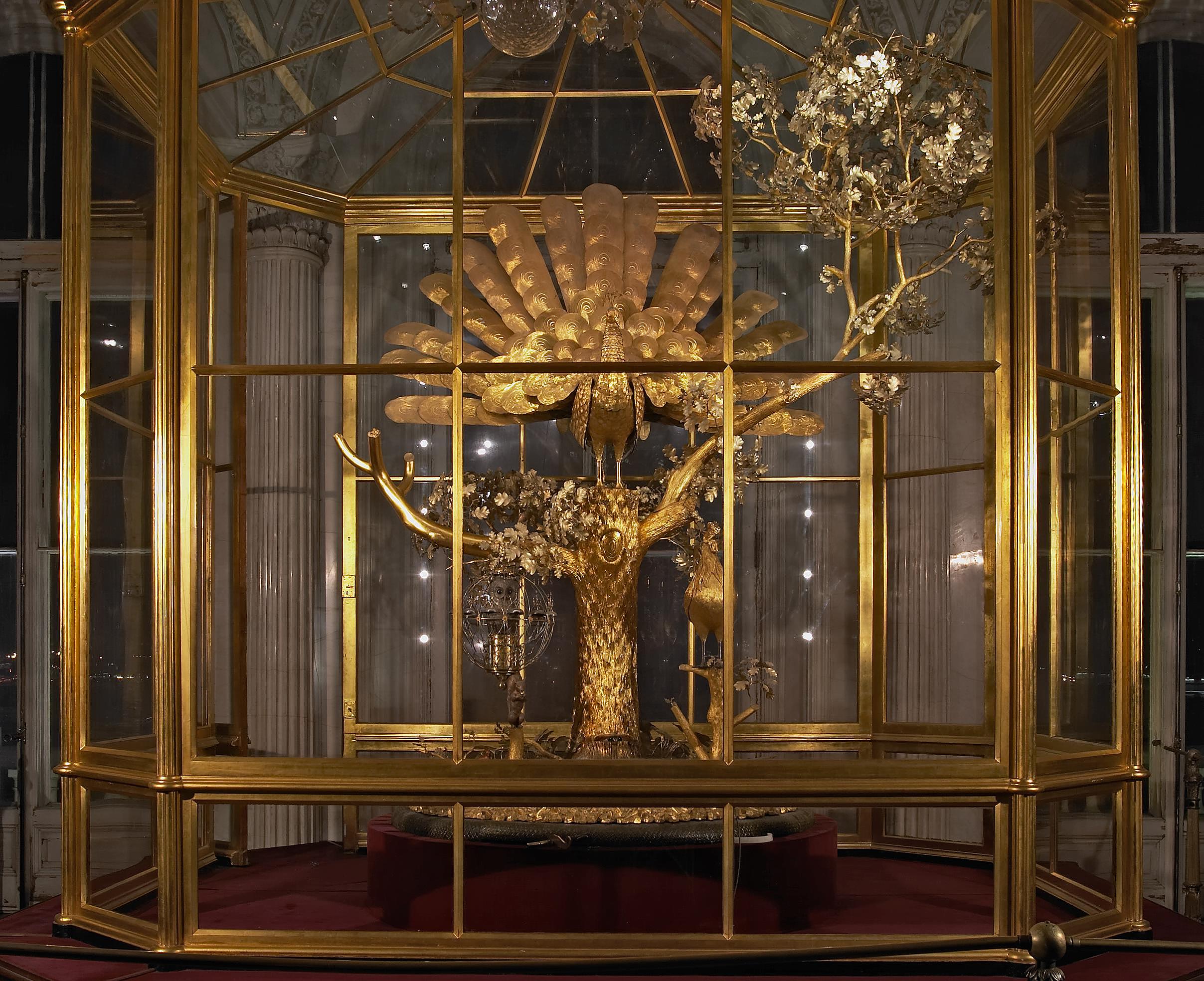The Peacock Clock at the Hermitage
By Magdalena Polak
7:55 pm at the Hermitage Museum in Saint Petersburg. I am standing in the Peacock Salon, which is bursting with people. Everyone wishes to have a good look at the gilded aviary in the otherwise empty room; the majestic Peacock Clock was created by the eighteenth-century manufacturer of curiosities, James Cox.
Not just a clock but rather a musical automaton, this true work of art offers a spectacle of an owl, a rooster, a peacock, and squirrels sitting on the branches of an oak tree. Every Wednesday at 8 pm, the automaton is wound up, which causes four different mechanisms to be set in motion, creating bell-like music. Then, all of a sudden, the owl starts fluttering its eyes, twisting its head, raising its paw, all the while hooting. It is joined by the peacock’s regal raising head, after which it opens its majestic golden tail, causing the audience to exclaim in wonder. Slowly turning around, the peacock stands still for a moment, allowing the audience to study the detailed crafting of the golden feathers, before turning back and closing it again.
The spectacle ends with the rooster crowing four times, an action reminiscent of a cuckoo clock. Slowly, the last notes of the music fade away. There are a few precious moments of silence as the audience digests the magical experience; then the chatter re-emerges and the audience disperses in all directions.
James Cox, Peacock Clock, 1770s. https://www.hermitagemuseum.org/wps/portal/hermitage/digital-collection/08.+Applied+Arts/52984/?lng=en
Despite surprisingly large gaps in James Cox’ biography, it is apparent that he was undoubtedly one of the most celebrated creators of unique mechanisms in the eighteenth-century. Born in London in 1723, he was the son of a tailor who was initially trained as a goldsmith. However, the fact that he set up a workshop of curiosities the same year that he finished his apprenticeship, suggests a self-confidence in his artistic talents that would not waver over the course of his career, despite several bankruptcies and personal tragedies. Starting his career by creating clocks of artistic mastery, he caused a national stir and established himself as a true artist of the Enlightenment with the opening of his own museum, the Spring Gardens, in 1771, where he exhibited mechanical automata of different animals and human beings. Unfortunately, little has survived to the present day; however, another example of his creativity would be the Silver Swan, currently possessed by the Bowles Museum in Barnard Castle, England. The life-sized automaton shows a swan sitting on water made out of glass rods in which small fish can be seen swimming. When the automaton is set in motion, music is played and the glass rods start moving, creating the illusion of moving water, and the swan bends its neck, giving the illusion of trying to catch a fish. Cox became famous for these musical automata, which he exported around the world, even as far as China.
James Cox, Silver Swan, 1773.
http://www.bshs.org.uk/travel-guide/wp-content/uploads/2501029089_2e893cc89c_z.jpg
After being created England in the 1770s, the Peacock clock was brought to Russia as a gift from Prince Grigory Potemkin to Empress Catherine II in 1781, a present, which, for various reasons, fit the image Catherine wanted to create for herself. The existence of the Hermitage as we know it today is entirely down to her; a proclaimed follower of the Enlightenment, Catherine wished to position Russia at the centre of culture and learning, not only rivalling, but surpassing other European states. The result was remarkable; over the course of twenty years, Catherine had managed to collect over four thousand paintings and no less than ten thousand drawings, rivalling many European Royal collections.
James Cox’s Peacock Clock fit perfectly with the Enlightened image she wished to create for herself and therefore, by extension, the Hermitage. Recreating nature through man’s rationally perceived creations, thus setting man, not God, at the very top of the universe, was one of the fundamental ideas of the Enlightenment. It meant a challenging of the hierarchical and unquestionable authority of the Church, and an Enlightened ruler was therefore a symbol of knowledge and power.
Despite the strategic and rational explanations why the Peacock clock fits into the Hermitage collection, I personally cannot help but see all the evidence of a true work of art. James Cox’s unwavering commitment to mechanical automata, despite more than one financial and personal setback, expresses an uncompromising dedication to his cause. The Peacock automaton combines sheer beauty with learnt, technical skill. It is an object that represents the fleeting nature of time, and therefore, life. It crosses borders, both figuratively, in the sense that a mechanism such as this had never before been created, as well as literally, having travelled all the way from London to Saint Petersburg. It brings people together, as I have personally witnessed, fighting my way through the crowded room to have a better view. And finally, it is timeless. What an amazing thing it is that sometimes, man’s creations can delight people in 2018 just as much as they did in 1781.
Bibliography
Clifford, Timothy. “Anglomania: Catherine's patronage of British decorative arts,” The British Art Journal, Vol. 2, No. 2, Somerset House (Winter 2000/2001).
Dianina, Katia. “Art and Authority: The Hermitage of Catherine the Great,” The Russian Review, Vol. 63, No. 4 (Oct., 2004).
Smith, Robert. “James Cox (c. 1723-1800): A Revised Biography,” The Burlington Magazine, Vol. 142, No. 1167 (Jun., 2000).
The State Hermitage Museum, “The Peacock Clock”, Youtube video, 3:35, August 18, 2017, https://www.youtube.com/watch?v=ilPlVRoUl_8


